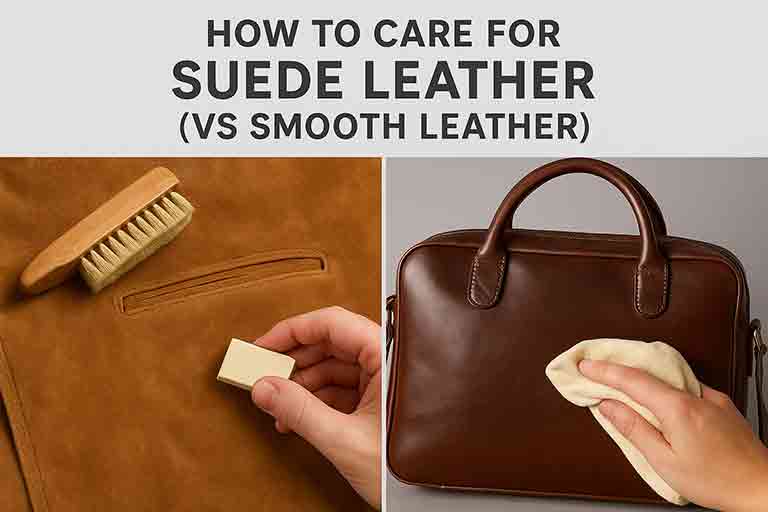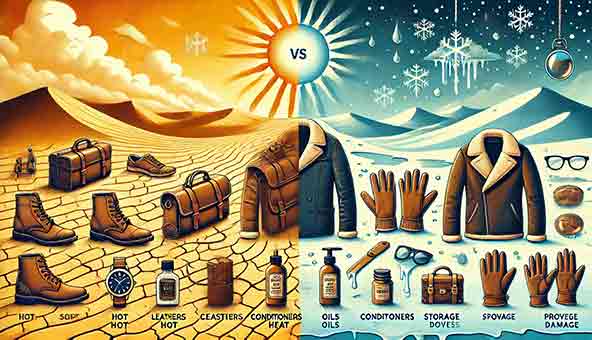
How Climate Affects Leather — Tips for Hot And Cold Regions
, by Syed Khawar Bukhari, 6 min reading time

, by Syed Khawar Bukhari, 6 min reading time
Leather is a timeless material known for its durability, elegance, and versatility, but its quality and lifespan can be significantly influenced by climate conditions. Whether you live in hot, humid regions or cold, dry environments, knowing how climate impacts leather is crucial for proper care and maintenance. This comprehensive guide explores how temperature, humidity, and environmental exposure affect different types of leather, along with actionable tips for preserving its beauty and strength in both hot and cold regions.
Leather is a natural material derived from animal hides. Its porous structure allows it to breathe, absorb, and release moisture, which makes it sensitive to environmental changes. Unlike synthetic materials, leather reacts directly to climate factors such as heat, cold, sunlight, and humidity.
Moisture sensitivity: Too much humidity can cause leather to mold or stretch, while dryness can lead to cracks.
Heat vulnerability: High temperatures accelerate the breakdown of natural oils in leather.
Cold effects: Extreme cold stiffens leather, making it prone to cracking and brittleness.
Understanding these characteristics is essential for tailoring leather care routines to your specific regional climate.
In hot regions, especially those with strong sun exposure, leather is at risk of fading, drying, and cracking. Ultraviolet (UV) rays penetrate leather fibers, breaking down natural oils that keep it supple. Over time, this leads to discoloration and stiffness.
Tropical climates combine heat with high humidity, which can be even more damaging. Moisture is easily absorbed by leather, causing it to stretch, warp, or develop mold. In extreme cases, constant dampness may lead to permanent damage or unpleasant odors.
Use UV protection: Apply a leather conditioner with UV filters to prevent fading.
Keep leather ventilated: Store items in breathable cotton bags instead of plastic.
Control humidity indoors: Use dehumidifiers to protect leather furniture and apparel.
Regular conditioning: Restore natural oils with a high-quality conditioner every few weeks.
Cold climates often come with low humidity. Leather exposed to dry winter air loses its moisture rapidly, leading to stiffness and cracks. This is particularly common in boots, jackets, and gloves used in snowy regions.
In snowy areas, leather shoes and jackets frequently come into contact with salt and moisture. Road salt, while helpful for melting ice, leaves white stains and dehydrates leather fibers. Repeated exposure without proper care can cause irreparable damage.
Sudden temperature shifts—like moving from a warm indoor space to freezing outdoor weather—can stress leather, making it more brittle.
Moisturize regularly: Apply a hydrating conditioner to prevent dryness and cracking.
Protect from salt: Use a protective spray to shield leather footwear from snow and salt stains.
Avoid direct heat: Do not place leather items near radiators or heaters, as this accelerates drying.
Store carefully: Keep leather in a cool, dry space with moderate humidity.
Many regions experience seasonal climate changes, shifting from humid summers to dry winters. This can be particularly challenging for maintaining leather items year-round.
Seasonal cleaning: Thoroughly clean and condition leather at the start and end of each season.
Adjust products: Use lightweight conditioners in summer and richer, oil-based ones in winter.
Climate-appropriate storage: Rotate storage methods depending on seasonal humidity levels.
When traveling with leather goods, be aware of the destination’s climate. A leather bag that thrives in a dry region may need extra protection when carried into a humid environment. Portable leather wipes and compact conditioners can be invaluable.
Avoid basements and attics: These spaces are prone to fluctuating temperatures and humidity.
Use climate-controlled storage: Especially important for high-value leather goods.
Breathable bags: Cotton or linen garment bags allow airflow while protecting from dust.
No plastic wraps: Plastic traps moisture, leading to mildew growth.
Leather needs to breathe. Overcrowding closets with jackets or storing bags tightly together restricts airflow, causing musty odors and mold risks.
Sometimes home care isn’t enough, especially if your leather has suffered severe climate-related damage. Professional leather care services can:
Deep-clean and remove salt, mold, or stubborn stains.
Recondition and restore faded or cracked areas.
Apply protective coatings suitable for your specific climate.
Periodic professional treatment can extend the lifespan of your leather items by years.
Not all leathers respond the same way to climate challenges.
Full-grain leather: Most durable, but still requires conditioning in extreme climates.
Top-grain leather: Slightly more processed, less breathable, but more resistant to stains.
Suede and nubuck: Extremely sensitive to both humidity and dryness, requiring extra protection.
Patent leather: Better resistance to moisture but prone to cracking in cold climates.
Choosing the right leather type for your region can reduce maintenance demands significantly.
For those in challenging climates, vegan leather and modern treated leathers may provide better resilience. Many synthetic or plant-based leathers are designed to withstand humidity, salt, and extreme temperatures without requiring extensive upkeep. While they may not match the natural patina of real leather, they can be practical for certain climates.
Leather is an investment that can last decades if cared for properly. Climate plays a central role in determining how leather ages, making it essential to adapt care routines based on whether you live in hot, humid, or cold, dry environments. By using the right protective products, controlling storage conditions, and applying regular maintenance, you can ensure your leather goods remain supple, stylish, and strong no matter where you are.
From tropical humidity to winter snow, the right knowledge and preparation will keep your leather in its best condition, allowing it to serve you with both practicality and timeless elegance for years to come.


